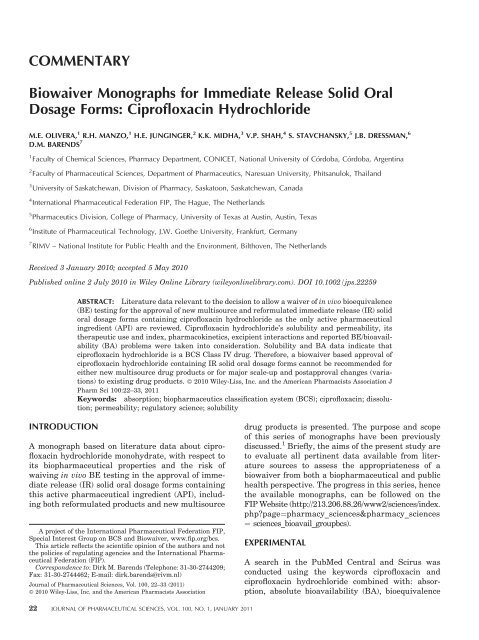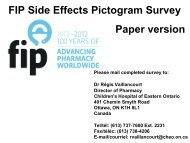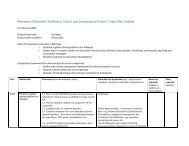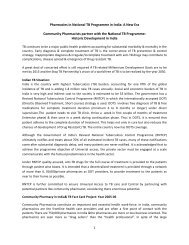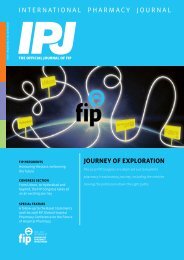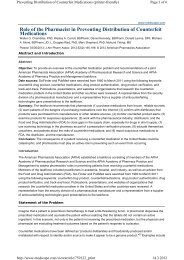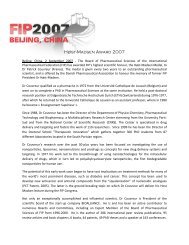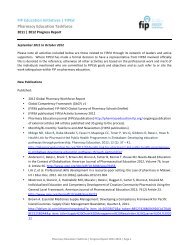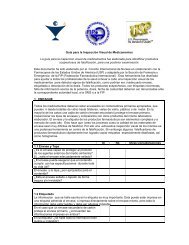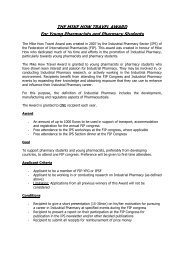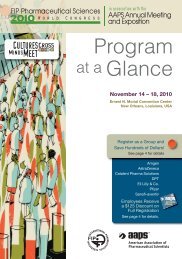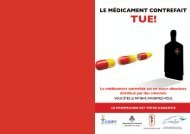Biowaiver monographs for immediate release solid oral dosage - FIP
Biowaiver monographs for immediate release solid oral dosage - FIP
Biowaiver monographs for immediate release solid oral dosage - FIP
Create successful ePaper yourself
Turn your PDF publications into a flip-book with our unique Google optimized e-Paper software.
COMMENTARY<br />
<strong>Biowaiver</strong> Monographs <strong>for</strong> Immediate Release Solid Oral<br />
Dosage Forms: Ciprofloxacin Hydrochloride<br />
M.E. OLIVERA, 1 R.H. MANZO, 1 H.E. JUNGINGER, 2 K.K. MIDHA, 3 V.P. SHAH, 4 S. STAVCHANSKY, 5 J.B. DRESSMAN, 6<br />
D.M. BARENDS 7<br />
1<br />
Faculty of Chemical Sciences, Pharmacy Department, CONICET, National University of Córdoba, Córdoba, Argentina<br />
2 Faculty of Pharmaceutical Sciences, Department of Pharmaceutics, Naresuan University, Phitsanulok, Thailand<br />
3 University of Saskatchewan, Division of Pharmacy, Saskatoon, Saskatchewan, Canada<br />
4 International Pharmaceutical Federation <strong>FIP</strong>, The Hague, The Netherlands<br />
5 Pharmaceutics Division, College of Pharmacy, University of Texas at Austin, Austin, Texas<br />
6 Institute of Pharmaceutical Technology, J.W. Goethe University, Frankfurt, Germany<br />
7 RIMV – National Institute <strong>for</strong> Public Health and the Environment, Bilthoven, The Netherlands<br />
Received 3 January 2010; accepted 5 May 2010<br />
Published online 2 July 2010 in Wiley Online Library (wileyonlinelibrary.com). DOI 10.1002/jps.22259<br />
INTRODUCTION<br />
ABSTRACT: Literature data relevant to the decision to allow a waiver of in vivo bioequivalence<br />
(BE) testing <strong>for</strong> the approval of new multisource and re<strong>for</strong>mulated <strong>immediate</strong> <strong>release</strong> (IR) <strong>solid</strong><br />
<strong>oral</strong> <strong>dosage</strong> <strong>for</strong>ms containing ciprofloxacin hydrochloride as the only active pharmaceutical<br />
ingredient (API) are reviewed. Ciprofloxacin hydrochloride’s solubility and permeability, its<br />
therapeutic use and index, pharmacokinetics, excipient interactions and reported BE/bioavailability<br />
(BA) problems were taken into consideration. Solubility and BA data indicate that<br />
ciprofloxacin hydrochloride is a BCS Class IV drug. There<strong>for</strong>e, a biowaiver based approval of<br />
ciprofloxacin hydrochloride containing IR <strong>solid</strong> <strong>oral</strong> <strong>dosage</strong> <strong>for</strong>ms cannot be recommended <strong>for</strong><br />
either new multisource drug products or <strong>for</strong> major scale-up and postapproval changes (variations)<br />
to existing drug products. ß 2010 Wiley-Liss, Inc. and the American Pharmacists Association J<br />
Pharm Sci 100:22–33, 2011<br />
Keywords: absorption; biopharmaceutics classification system (BCS); ciprofloxacin; dissolution;<br />
permeability; regulatory science; solubility<br />
A monograph based on literature data about ciprofloxacin<br />
hydrochloride monohydrate, with respect to<br />
its biopharmaceutical properties and the risk of<br />
waiving in vivo BE testing in the approval of <strong>immediate</strong><br />
<strong>release</strong> (IR) <strong>solid</strong> <strong>oral</strong> <strong>dosage</strong> <strong>for</strong>ms containing<br />
this active pharmaceutical ingredient (API), including<br />
both re<strong>for</strong>mulated products and new multisource<br />
A project of the International Pharmaceutical Federation <strong>FIP</strong>,<br />
Special Interest Group on BCS and <strong>Biowaiver</strong>, www.fip.org/bcs.<br />
This article reflects the scientific opinion of the authors and not<br />
the policies of regulating agencies and the International Pharmaceutical<br />
Federation (<strong>FIP</strong>).<br />
Correspondence to: Dirk M. Barends (Telephone: 31-30-2744209;<br />
Fax: 31-30-2744462; E-mail: dirk.barends@rivm.nl)<br />
Journal of Pharmaceutical Sciences, Vol. 100, 22–33 (2011)<br />
ß 2010 Wiley-Liss, Inc. and the American Pharmacists Association<br />
22 JOURNAL OF PHARMACEUTICAL SCIENCES, VOL. 100, NO. 1, JANUARY 2011<br />
drug products is presented. The purpose and scope<br />
of this series of <strong>monographs</strong> have been previously<br />
discussed. 1 Briefly, the aims of the present study are<br />
to evaluate all pertinent data available from literature<br />
sources to assess the appropriateness of a<br />
biowaiver from both a biopharmaceutical and public<br />
health perspective. The progress in this series, hence<br />
the available <strong>monographs</strong>, can be followed on the<br />
<strong>FIP</strong> Website (http://213.206.88.26/www2/sciences/index.<br />
php?page¼pharmacy_sciences&pharmacy_sciences<br />
¼ sciences_bioavail_groupbcs).<br />
EXPERIMENTAL<br />
A search in the PubMed Central and Scirus was<br />
conducted using the keywords ciprofloxacin and<br />
ciprofloxacin hydrochloride combined with: absorption,<br />
absolute bioavailability (BA), bioequivalence
(BE), dissolution, excipients, partition coefficient,<br />
permeability, pharmacokinetics, polymorphism, <strong>oral</strong>,<br />
and solubility. Whenever possible, original literature<br />
was consulted and data from secondary sources were<br />
included <strong>for</strong> completeness or when original literature<br />
could not be located.<br />
RESULTS<br />
Figure 1. Structure of ciprofloxacin.<br />
General Characteristics<br />
Name<br />
Ciprofloxacin (INN), structure shown in Figure 1.<br />
Therapeutic Indications and Therapeutic Index<br />
Ciprofloxacin is a broad-spectrum bactericidal antiinfective<br />
agent of the fluoroquinolone class. It is<br />
available in more than 100 countries, where it is<br />
approved <strong>for</strong> the treatment of 14 types of infections,<br />
especially urinary tract infections such as acute<br />
uncomplicated cystitis and chronic bacterial prostatitis,<br />
and lower respiratory infections. 2,3 The most<br />
frequent adverse reactions include nausea, vomiting,<br />
diarrhea, abdominal pain, rash, headache, and restlessness.<br />
4 Rare allergic reactions such as hives and<br />
anaphylaxis have been described. Serious adverse<br />
effects include drug-induced psychosis, immunogenic<br />
hypersensitivity reaction, peripheral neuropathy,<br />
raised intracranial pressure, seizure, tendinitis,<br />
traumatic, or nontraumatic rupture of tendon. 4 Acute<br />
renal failure has also been described, mostly in cases<br />
related to overdose, 5,6 but sometimes at ciprofloxacin<br />
<strong>dosage</strong>s within therapeutic schedules. 7,8 Because of<br />
its potency, broad-spectrum activity and general<br />
safety, ciprofloxacin is usually reserved as a drug of<br />
last resort to treat antibiotic-resistant infections. 3<br />
Chemical Properties<br />
Salts, Isomers, and Polymorphs<br />
The United States Pharmacopeia (USP) 9 contains a<br />
monograph <strong>for</strong> ciprofloxacin hydrochloride and the<br />
European Pharmacopeia (EP) 10 has a monograph <strong>for</strong><br />
the anhydrous <strong>for</strong>m of ciprofloxacin hydrochloride.<br />
BIOWAIVER MONOGRAPH FOR CIPROFLOXACIN HYDROCHLORIDE 23<br />
The hydrochloride and the free base are in regular<br />
therapeutic use. Stoichiometric metallic complexes<br />
between ciprofloxacin and metals have been reported<br />
but they are not in regular therapeutic use. 11–13<br />
Polymorphic <strong>for</strong>ms and stereoisomers have not been<br />
reported.<br />
Dissociation Constants<br />
Ciprofloxacin is a zwitterionic molecule containing<br />
two proton-binding sites. At 378C, values of pKa1<br />
and pKa2 are 6.2 and 8.59, respectively, have been<br />
reported. 14 At 258C, pKa values of 6.8 and 8.73–8.76<br />
were reported. 15,16<br />
Partition Coefficient<br />
The n-octanol/pH 7.0 buffered solution partition<br />
coefficient (log P) of ciprofloxacin was reported as<br />
0.94 at 378C, 16 1.45 (temperature not given) 14 and<br />
1.70 at 258C and pH 7.2. 17 Similarly, calculations<br />
using fragmentation methods based on atomic contributions<br />
to lipophilicity employing the C log P 1 gave<br />
values of 1.15 <strong>for</strong> C log P and 1.32 <strong>for</strong> log P. These<br />
values are lower than the corresponding values of<br />
1.35 (C log P) and 1.72 (log P) <strong>for</strong> the highly permeable<br />
marker drug metoprolol. 18<br />
Solubility<br />
As other fluoroquinolones ciprofloxacin is zwitterionic<br />
and exhibits a ‘‘U’’ shaped pH-solubility profile, with<br />
high solubility at pH values below 5 and above 10,<br />
and minimum solubility near the isoelectric point,<br />
which is close to neutral. The USP 9 reports the aqueous<br />
unbuffered solubility of ciprofloxacin hydrochloride,<br />
which has a final acidic pH. The solubility in<br />
phosphate buffer was in<strong>for</strong>med at pH 6.8 and 7.5 and<br />
378C. 19 Several pH-solubility profiles of ciprofloxacin<br />
hydrochloride have been reported at 258C. 20–22 The<br />
data and the corresponding dose:solubility ratios (D/<br />
S) are summarized in Table 1 <strong>for</strong> the usual range<br />
of tablet strengths (see below). The intrinsic solubility<br />
of ciprofloxacin, that is, the solubility of the neutral<br />
<strong>for</strong>m, also has been determined at different<br />
temperatures. 14,23<br />
Dosage Form Strength<br />
Doses and strengths of ciprofloxacin hydrochloride<br />
are expressed in terms of its base. 24 The dose of<br />
ciprofloxacin (as hydrochloride) recommended by<br />
WHO is 250 mg. 25 Tablets of ciprofloxacin hydrochloride<br />
marketed in Argentina contain 100, 250, 500,<br />
and 750 mg (ciprofloxacin equivalent) strengths. 26 In<br />
most other countries, the same range of strengths has<br />
been registered; see Table 2. 27–36<br />
DOI 10.1002/jps JOURNAL OF PHARMACEUTICAL SCIENCES, VOL. 100, NO. 1, JANUARY 2011
24 OLIVERA ET AL.<br />
Table 1. Solubility of Ciprofloxacin Hydrochloride and Corresponding D/S Ratios <strong>for</strong> Three Usual Tablet Strengths<br />
pH 8C Medium<br />
3–4.5 25 Water 10–30<br />
4.5 25 Water þ NaOH to indicated pH 3.5<br />
6.8 25 Water þ NaOH to indicated pH 0.0813<br />
6.8 37 Phosphate buffer 0.17<br />
6.84 25 Water þ NaOH to indicated pH 0.088<br />
7.5 25 Water þ NaOH to indicated pH 0.0702<br />
7.5 37 Phosphate buffer 0.16<br />
a<br />
Expressed in mg of the ciprofloxacin base.<br />
b 76–78<br />
Cut-off limit: 250 mL.<br />
c 26<br />
Highest strength on WHO list of essential medicines.<br />
Pharmacokinetic Properties<br />
Bioavailability<br />
The BA of ciprofloxacin was studied by several authors.<br />
Doses of 200 mg were given to 12 healthy<br />
volunteers <strong>oral</strong>ly in a randomized, crossover design,<br />
1 week apart, and as a 10 min intraveneous (i.v.)<br />
infusion. Absorption was rapid, with peak concentrations<br />
in serum occurring at 0.71 0.15 h. Absolute<br />
BA, defined as the ratio of the Area Under the Curve<br />
from 0 h to infinity (AUC0–1) <strong>for</strong> the <strong>oral</strong> to the i.v.<br />
dose was 69 7%. 37 In other study, the AUC obtained<br />
after administration of a single <strong>oral</strong> dose of 500 mg<br />
was compared with that obtained with a single i.v.<br />
infusion of 400 mg over 60 min; AUC<strong>oral</strong>/AUCi.v. was<br />
0.74 0.03; The absolute BA was 56%. 38 Other<br />
workers determined the pharmacokinetic parameters<br />
of ciprofloxacin after the <strong>oral</strong> administration of 50,<br />
100, and 750 mg, as well as 50 and 100 mg i.v., over<br />
15 min. 39 Serum and urine concentrations were determined<br />
with a bioassay. Absolute BA varied between<br />
77 16% and 63 15% after <strong>oral</strong> administration of 50<br />
and 100 mg. When normalized to 0.1 g of ciprofloxacin,<br />
the Cmax and the AUC0–1 after the 750 mg<br />
dosing were smaller than after the 50 or 100 mg <strong>oral</strong><br />
dosing ( p < 0.05) and the higher <strong>dosage</strong> tended<br />
towards a delay in absorption. 39<br />
Other authors found that the mean BA of ciprofloxacin<br />
at <strong>oral</strong> doses of 200 and 750 mg was nearly<br />
identical (69.0% and 69.1%). The BA of the 750 mg<br />
dose was, however, significantly more variable than<br />
observed with the 200 mg dose. But tmax was significantly<br />
longer with the 750 mg dose than with the<br />
200 mg dose (1.38 h vs. 0.69 h). Also, Cmax, normalized<br />
to a dose of 750 mg, was significantly higher with the<br />
smaller dose (4.4 mg/mL vs. 3.0 mg/mL). 40 The slower<br />
absorption rate constant observed in the larger dose<br />
and the possible influence of changing gastrointestinal<br />
(GI) motility and blood flow may have contributed<br />
to this variability. The prolongation of absorption and<br />
the variability in BA observed in the larger dose most<br />
Solubility a<br />
(mg/mL) References<br />
9<br />
20<br />
20<br />
19<br />
21,22<br />
20<br />
19<br />
250 mg c<br />
D/S Ratio b (mL)<br />
500 mg 750 mg<br />
8–25 17–50 25–75<br />
71 143 214<br />
3075 6150 9225<br />
1470 2941 4412<br />
2840 5682 8523<br />
3536 7072 10,608<br />
1562 3125 4687<br />
likely reflected variable disintegration/dissolution<br />
rate with the 750 mg tablet versus the 200 mg<br />
tablets.<br />
Tartaglione et al. 41 reported mean C max and AUC<br />
values to increase in proportion after sequential<br />
increasing <strong>oral</strong> dosing of 250, 500, 750, and 1000 mg.<br />
Interestingly, they observed that the absorption<br />
phase of their data were best fitted by a zero-order<br />
equation and suggested that events leading up to the<br />
absorption step could be which are rate limiting, thus<br />
<strong>for</strong>cing the absorption to appear to be zero order. This<br />
could be likely due to in vivo dissolution problems.<br />
Since ciprofloxacin is a zwitterionic drug and is<br />
probably absorbed by passive diffusion, intestinal pH<br />
changes suggest that rapid absorption may occur<br />
in the duodenum and proximal jejunum, whereas<br />
absorption may decrease in the distal portion of the<br />
intestine. 41 Other authors, 42 using HPLC methodology,<br />
could not detect dose disproportionality in<br />
ciprofloxacin kinetics after a single <strong>oral</strong> administration<br />
of 100, 250, 500, or 1000 mg. Nonetheless, no<br />
other reports on dose proportionality problems could<br />
be identified.<br />
Except <strong>for</strong> an increase in the time to achieve Cmax,<br />
significant food–drug interactions have not identified<br />
in the reviewed literature, 43,44 although when administered<br />
with calcium-<strong>for</strong>tified orange juice or dairy<br />
products a significant decrease in BA has been<br />
observed. 45,46<br />
Ciprofloxacin and other quinolones chelate with<br />
cations such as aluminum, magnesium, calcium, iron,<br />
and zinc. Clinically relevant drug–drug interactions<br />
between ciprofloxacin and metal cations have been<br />
extensively described. 47–49 Although the biopharmaceutical<br />
mechanism of this interaction is still not<br />
understood, a recent report clearly shows that the<br />
metal cations do not affect the solubility of fluoroquinolone<br />
and when they do, such solubility increases.<br />
So, a decrease in solubility cannot explain the<br />
lower BA observed when metal ions are coadministered.<br />
50<br />
JOURNAL OF PHARMACEUTICAL SCIENCES, VOL. 100, NO. 1, JANUARY 2011 DOI 10.1002/jps
Table 2. Excipients Present in Ciprofloxacin Hydrochloride IR Solid Oral Drug Products With a Marketing<br />
Authorization (MA) in Germany (DE), Denmark (DK), Finland (FI), France (FR), The Netherlands (NL), Norway (NO), Spain<br />
(ES), Sweden (SE), United Kingdom (UK) and the United States (US), and the Minimal and Maximal Amount of that<br />
Excipient Present Pro-Dosage Unit in Solid Oral Drug Products With a MA in the US<br />
Excipient<br />
BIOWAIVER MONOGRAPH FOR CIPROFLOXACIN HYDROCHLORIDE 25<br />
Drug Products Containing that Excipient With a MA Granted by<br />
the Named Country<br />
Range Present in<br />
Solid Oral Dosage<br />
Forms With a MA<br />
in the USA (mg)<br />
Carmellose sodium NL (1) 2.2–160<br />
Cellulose DE (2–25) DK (26–51) ES (52–98) FI (99–108) FR (109–125) NL (1,<br />
126–139) NO (140–145) SE (146–158)<br />
UK (159) US (160–165)<br />
4.6–1385 a<br />
Croscarmellose sodium DE (2, 3, 7, 8, 12, 15, 23, 24) DK (26, 27, 31, 33, 35, 37) ES (73, 86,<br />
94) FI (99–102) FR (114, 116, 119, 122) NL (127, 130, 131, 133–<br />
135, 139) NO (144) SE (148–150, 155) US (164)<br />
2–180<br />
Crospovidone DE (5, 6, 10, 11, 13, 14, 16, 18–22, 25) DK (28–30, 32, 34, 36, 38–51)<br />
ES (52, 54, 58, 59, 61, 63, 66, 69–71, 74, 76–78, 80–82, 90, 91, 93,<br />
95, 96, 98) FI (104–108) FR (109–113, 115, 117, 120, 121, 123–<br />
125) NL (126, 128, 129, 132, 136–138) NO (140, 141, 143, 145) SE<br />
(146, 147, 151, 153, 154, 156–158) UK (159) US (160, 162, 166)<br />
4.4–792 a<br />
Disodium edetate DE (17) ES (85, 87–89, 97) 0.21–4<br />
Hydroxypropylcellulose DE (167–170) 4–132<br />
Hypromellose DE (2–21, 23–25, 167–170) DK (28, 29, 32, 34, 36, 38–41, 43–51) ES<br />
(52, 56, 57, 60, 61, 63, 70, 73, 74, 76, 77, 80, 83–89, 91, 92, 94, 95,<br />
97) FI (101, 104–106) FR (109, 110, 112–114, 119–121, 123–125)<br />
NL (1, 126, 128, 131, 135, 137, 171, 172) NO (140, 142, 143, 145)<br />
SE (146, 153, 154, 158) US (160, 161, 163–166)<br />
0.8–86<br />
Lactose DE (12) NL (171, 172) 23–1020 a<br />
Macrogol DE (2–22, 25, 167–170) DK (28, 29, 32, 34, 36, 38–41, 43–51) ES<br />
(52, 55, 57, 61, 65, 73, 76, 77, 80, 85–89, 91, 94, 95, 97) FI (101,<br />
104–106) FR (109, 112–114, 120, 121, 123–125) NL (126, 128,<br />
137, 171, 172) NO (140–143, 145) SE (146, 153, 154, 158) US<br />
(160–166)<br />
0.12–500 a<br />
Magnesium stearate DE (2–25, 167–170) DK (26–51) ES (52–98) FI (99–108) FR (109–<br />
125) NL (1, 126–139) NO (140–145) SE (146–158) UK (159) US<br />
(160–166)<br />
0.15–401 a<br />
Polydextrose DE (19) DK (41) US (165) 3.8–8.1<br />
Polysorbate 80 ES (56, 60, 92) 2.2–418 a<br />
Poly (vinylalcohol) DE (22) NO (141) US (162) 0.7–20<br />
Povidone DE (2, 3, 7, 8, 12, 15, 23, 24) DK (26, 27, 31, 33, 35, 37) ES (53, 55,<br />
57, 64, 65, 67, 68, 72, 79) FI (99–102) FR (114, 116, 119, 122) NL<br />
(1, 127, 130, 131, 133–135, 139, 171, 172) NO (142, 144) SE (148–<br />
150, 155) US (161, 164)<br />
0.17–75<br />
Propylene glycol DE (23, 24) ES (55, 56, 60, 65, 92) FR (119) NL (1, 131, 135) 1.5–52<br />
Silica DE (2–11, 13–25) DK (26–51) ES (52–54, 56–64, 66–98) FI (99–<br />
108) FR (109–115, 117–125) NL (1, 126–139) NO (140–145) SE<br />
(146–158) UK (159) US (160–166)<br />
0.65–99<br />
Sodium citrate DE (12) 18–275<br />
Sodium lauryl sulphate ES (73, 86, 94) 0.65–50<br />
Sodium starch glycolate DE (2–4, 7–9, 15, 17, 23, 24, 167–170) DK (31, 33, 35, 37) ES (55,<br />
56, 60, 62, 63, 65, 69–71, 74, 75, 78, 83–85, 87–90, 92, 93, 97, 98)<br />
FI (99, 102, 103) FR (110, 114, 118, 119) NL (1, 127, 131, 133–<br />
135, 139, 171, 172) NO (142) SE (149, 150, 152) US (161, 163,<br />
165)<br />
2–876 a<br />
Sodium stearyl fumarate NL (171, 172) 1.2–26<br />
Starch DE (4–6, 9, 17, 19, 21, 22) DK (28, 29, 36, 41, 42) ES (53, 54, 56–60,<br />
62, 64, 66–68, 72, 73, 75, 76, 79, 82–89, 91, 92, 94, 96, 97) FI (103,<br />
108) FR (109, 111, 115, 117, 118, 125) NL (126, 129, 138) NO<br />
(141, 145) SE (147, 151, 152, 156–158) UK (159) US (160, 162,<br />
163)<br />
Starch, pregelatinized DE (19, 22) DK (41, 42) ES (52, 61, 77, 80, 81, 95) FR (111, 115, 117)<br />
NL (129, 138) NO (141) SE (147, 151, 156, 157) US (165)<br />
6.6–600<br />
0.44–1135 a<br />
DOI 10.1002/jps JOURNAL OF PHARMACEUTICAL SCIENCES, VOL. 100, NO. 1, JANUARY 2011
26 OLIVERA ET AL.<br />
Table 2. (Continued )<br />
Excipient<br />
Drug Products Containing that Excipient With a MA Granted by<br />
the Named Country<br />
Range Present in<br />
Solid Oral Dosage<br />
Forms With a MA<br />
in the USA (mg)<br />
Stearic acid DE (2, 3, 7, 8, 15) DK (33, 37) FI (102) FR (114) NL (127, 133, 134)<br />
NO (142) SE (149)<br />
Succinic acid US (166) 65<br />
Talc DE (2–4, 7, 8, 15, 17, 22–24) ES (55, 56, 60, 62, 65, 73, 75, 85–89, 92,<br />
94, 97) FI (103) FR (114, 118, 119) NL (1, 131, 135) NO (141, 142)<br />
SE (152) US (162, 163, 165)<br />
Triacetin DE (19) DK (41) ES (63, 70, 74) FR (110) US (165) 0.72–15<br />
0.9–72 a<br />
0.25–220 a<br />
(1) Ciprofloxacine ratiopharm 250 mg/500 mg/750 mg tabletten; (2) Cipro—1 A Pharma 1 100 mg Filmtabletten (Mono); (3) Cipro—1 A Pharma 1 250 mg/<br />
500 mg/750 mg Filmtabletten (Mono); (4) CIPRO BASICS 250 mg/500 mg Filmtabletten (Mono); (5) Ciprobay 1 250 mg/500 mg/750 mg Filmtabletten (Mono);<br />
(6) Ciprobay 1 Uro Filmtabletten (100 mg) (Mono); (7) Ciprobeta 1 250 mg/500 mg/750 mg Filmtabletten (Mono); (8) Ciprobeta 1 Uro 100 mg Filmtabletten (Mono);<br />
(9) Ciprofloxacin 250 mg/500 mg DeltaSelect Filmtabletten (Mono); (10) Ciprofloxacin AbZ 100 mg/250 mg/500 mg Filmtabletten (Mono); (11) Ciprofloxacin AL uro<br />
100 mg/Ciprofloxacin AL 250 mg/500 mg/750 mg Filmtabletten (Mono); (12) Ciprofloxacin AWD 1 250 mg/500 mg Filmtabletten (Mono); (13) Ciprofloxacinratiopharm<br />
1 100 mg/250 mg/500 mg/750 mg Filmtabletten (Mono); (14) Ciprofloxacin Sandoz 1 100 mg Filmtabletten (Mono); (15) Ciprofloxacin Sandoz 1 250 mg/<br />
500 mg/750 mg Filmtabletten (Mono); (16) Ciprofloxacin STADA 1 100 mg/250 mg/500 mg/750 mg Filmtabletten (Mono); (17) Ciprofloxacin TAD 250 mg/500 mg<br />
Filmtabletten (Mono); (18) Ciproflox-CT 100 mg/250 mg/500 mg Filmtabletten (Mono); (19) CIPROFLOX-PUREN 1 100 mg/250 mg/500 mg Filmtabletten (Mono);<br />
(20) CiproHEXAL 100 mg Filmtabletten (Mono); (21) CiproHEXAL 250 mg/500 mg/750 mg Filmtabletten (Mono); (22) Cipro-Q 1 250 mg/500 mg/750 mg Filmtabletten<br />
(Mono); (23) Cipro-saar 1 250 mg/500 mg Filmtabletten (Mono); (24) Gyracip 1 250 mg/500 mg/750 mg Filmtabletten (Mono); (25) Keciflox 1 100 mg/250 mg/<br />
500 mg/750 mg Filmtabletten (Mono); (26) Ciprofloxacin ‘‘Teva’’ filmovertrukne tabletter 100 mg/250 mg/500 mg/750 mg; (27) Ciprofloxacin ‘‘BMM Pharma,’’<br />
filmovertrukne tabletter 250 mg/500 mg/750 mg; (28) Ciprofloxacin ‘‘Copyfarm,’’ filmovertrukne tabletter 250 mg/500 mg/750 mg; (29) Ciprofloxacin ‘‘Pharmathen,’’<br />
filmovertrukne tabletter 250 mg/500 mg/750 mg; (30) Ciprofloxacin ‘‘Ratiopharm,’’ filmovertrukne tabletter 100 mg/250 mg/500 mg/750 mg; (31) Ciprofloxacin<br />
‘‘Alternova,’’ filmovertrukne tabletter 250 mg/500 mg/750 mg; (32) Ciprofloxacin ‘‘Actavis,’’ filmovertrukne tabletter 250 mg/500 mg/750 mg;<br />
(33) Ciprofloxacin ‘‘1A Farma,’’ filmovertrukne tabletter 250 mg/500 mg/750 mg; (34) Ciprofloxacin ‘‘Sandoz,’’ filmovertrukne tabletter 100 mg/250 mg/500 mg/<br />
750 mg; (35) Ciprofloxacin ‘‘Krka’’ filmovertrukne tabletter 250 mg/500 mg/750 mg; (36) Ciproxin, filmovertrukne tabletter 250 mg/500 mg/750 mg; (37) Ciprofloxacin<br />
‘‘HEXAL,’’ filmovertrukne tabletter 250 mg/500 mg/750 mg; (38) Ciprofloxacin ‘‘Pharmafile,’’ filmovertrukne tabletter 100 mg/250 mg/500 mg/750 mg;<br />
(39) Ciprofloxacin ‘‘Multipharma,’’ filmovertrukne tabletter 100 mg/250 mg/500 mg/750 mg; (40) Ciproscope, filmovertrukne tabletter 100 mg/250 mg/500 mg;<br />
(41) Ciprofloxacin ‘‘Merck NM,’’ filmovertrukne tabletter 100 mg/250 mg/500 mg/750 mg; (42) Ciprofloxacin ‘‘Arrow,’’ filmovertrukne tabletter 250 mg/500 mg/<br />
750 mg; (43) Ciproten, filmovertrukne tabletter 100 mg/250 mg/500 mg/750 mg; (44) Cidelta, filmovertrukne tabletter 100 mg/250 mg/500 mg/750 mg; (45) Ciprotabs,<br />
filmovertrukne tabletter 100 mg/250 mg/500 mg/750 mg; (46) Cifin, filmovertrukne tabletter 100 mg/250 mg/500 mg/750 mg; (47) Myrciprox, filmovertrukne<br />
tabletter 100 mg/250 mg/500 mg; (48) Ciprodane, filmovertrukne tabletter 100 mg/250 mg/500 mg/750 mg; (49) Cispharm, filmovertrukne tabletter 100 mg/<br />
250 mg/500 mg/750 mg; (50) Sancipro, filmovertrukne tabletter 100 mg/250 mg/500 mg/750 mg; (51) Ciprodis, filmovertrukne tabletter 100 mg; (52) CIPROAC-<br />
TIN 1 250 mg/500 mg/750 mg comprimidos recubiertos; (53) CIPROFLOXACINO ACOST 250 mg/500 mg comprimidos recubiertos con película EFG; (54) CIPRO-<br />
FLOXACINO QUALIGEN 250 mg/500 mg/750 mg comprimidos; (55) ESTECINA ‘‘250’’/‘‘500’’/‘‘750’’ Comprimidos recubiertos; (56) FELIXENE 1 500;<br />
(57) BAYCIP 1 250 mg/500 mg/750 mg, comprimidos; (58) BELMACINA 250 mg/500 mg/750 mg comprimidos recubiertos; (59) CIPROFLOXACINO BEXAL<br />
250 mg/500 mg/750 mg COMPRIMIDOS RECUBIERTOS EFG; (60) CETRAXAL 250 mg/500 mg/750 mg comprimidos recubiertos; (61) CIPROACTIN 1 250 mg/<br />
500 mg/750 mg comprimidos recubiertos; (62) CIPROFLOXACINO COMBIX 250 mg/500 mg/750 mg comprimidos recubiertos con película EFG; (63) CIPRO-<br />
FLOXACINO EDIGEN 250 mg/500 mg/750 mg, comprimidos recubiertos EFG; (64) CIPROFLOXACINO GRAPA 250 mg/500 mg COMPRIMIDOS RECUBIER-<br />
TOS CON PELÍCULA EFG; (65) CIPROFLOXACINO NORMON 250 mg/500 mg/750 mg Comprimidos Recubiertos EFG; (66) CIPROFLOXACINO TEVA 250 mg/<br />
500 mg/750 mg comprimidos recubiertos con película EFG; (67) CIPROFLOXACINO UR 250 mg/500 mg comprimidos recubiertos EFG; (68) CIPROFLOXACINO<br />
VIR 250 mg/500 mg COMPRIMIDOS RECUBIERTOS CON PELÍCULA EFG; (69) CIPROFLOXACINO ALTER 250 mg/500 mg/750 mg comprimidos recubiertos<br />
con película EFG; (70) CIPROFLOXACINO JUVENTUS 250 mg/500 mg/750 mg Comprimidos recubiertos con película EFG; (71) CIPROFLOXACINO KERN<br />
PHARMA 500 mg comprimidos EFG; (72) CIPROFLOXACINO LAREQ 250 mg/500 mg COMPRIMIDOS RECUBIERTOS CON PELÍCULA EFG; (73) CIPRO-<br />
FLOXACINO MABO 250 mg/500 mg/750 mg comprimidos recubiertos con película EFG; (74) CIPROFLOXACINO MERCK 250 mg/500 mg/750 mg comprimidos<br />
recubiertos EFG; (75) Ciprofloxacino Ranbaxy 250 mg/500 mg/750 mg comprimidos; (76) Ciprofloxacino Sandoz 250 mg/500 mg/750 mg comprimidos recubiertos<br />
con película EFG; (77) CIPROFLOXACINO TAUCIP 250 mg/500 mg/750 mg comprimidos recubiertos EFG; (78) CIPROFLOXACINO WINTHROP 250 mg/<br />
500 mg comprimidos EFG; (79) DORIMAN 250 mg/500 mg COMPRIMIDOS RECUBIERTOS CON PELÍCULA; (80) GLOBUCE 250 mg/500 mg/750 mg comprimidos<br />
recubiertos; (81) PIPROL 250 mg/500 mg/750; (82) RIGORAN 250 mg/500 mg/750 mg comprimidos; (83) SEPCEN 250 mg/500 mg/750 mg comprimidos<br />
recubiertos; (84) TAM 250 mg/500 mg/750 mg comprimidos recubiertos; (85) CIPROCTAL 250 mg/500 mg/750 mg comprimidos recubiertos con película; (86)<br />
Ciprofloxacino cinfamed 1 250 mg/500 mg/750 mg comprimidos recubiertos EFG; (87) CIPROFLOXACINO CUVE 250 mg/500 mg/750 mg comprimidos recubiertos<br />
con película EFG; (88) CIPROFLOXACINO DAVUR 250 mg/500 mg/750 mg comprimidos recubiertos con película EFG; (89) CIPROFLOXACINO KORHIS-<br />
PANA 250 mg/500 mg/750 mg comprimidos recubiertos con película EFG; (90) CIPROFLOXACINO STADA 250 mg/500 mg/750 mg comprimidos recubiertos con<br />
película EFG; (91) CIPROFLOXACINO SUMOL 1 250 mg/500 mg/750 mg comprimidos recubiertos con película EFG; (92) ULTRAMICINA 250 mg/500 mg<br />
comprimidos recubiertos; (93) CIPROFLOXACINO BELMAC 250 mg/500 mg/750 mg comprimidos EFG; (94) Ciprofloxacino cinfa 1 250 mg/500 mg/750 mg<br />
comprimidos recubiertos; (95) Ciprofloxacino ratiopharm 250 mg/500 mg/750 mg comprimidos recubiertos EFG; (96) Ciprofloxacino Tarbis 250 mg/500 mg/<br />
750 mg comprimidos EFG; (97) Ciprofloxacino Rimafar 250 mg/500 mg/750 mg comprimidos EFG; (98) Ciprofloxacino Farmabion 250 mg/500 mg/750 mg<br />
comprimidos recubiertos con película; (99) Ciprofloxacin Alternova 250 mg/500 mg/750 mg tabletti, kalvopäällysteinen; (100) Ciprofloxacin BMM Pharma<br />
250 mg/500 mg/750 mg tabletti, kalvopäällysteinen; (101) Ciprofloxacin Enna 250 mg/500 mg/750 mg tabletti, kalvopäällysteinen; (102) Ciprofloxacin HEXAL<br />
250 mg/500 mg/750 mg kalvopäällysteinen tabletti; (103) Ciprofloxacin Ranbaxy 250 mg/500 mg tabletit; (104) Ciprofloxacin ratiopharm 250 mg/500 mg/750 mg<br />
tabletti, kalvopäällysteinen; (105) Ciprofloxacin Sandoz 250 mg/500 mg/750 mg tabletti, kalvopäällysteinen; (106) Ciprofloxacin STADA 250 mg/500 mg/750 mg<br />
kalvopäällysteinen tabletti; (107) Cipromed 250 mg/500 mg/750 mg tabletti; (108) CIPROXIN 1 250 mg/500 mg/750 mg tabletti, kalvopäällysteinen; (109) CIFLOX<br />
250 mg/750 mg cp pellic mg/500 mg cp pellic séc; (110) CIPROFLOXACINE ALTER 250 mg/500 mg cp pellic; (111) CIPROFLOXACINE ARROW 250 mg/500 mg/<br />
750 mg cp pellic; (112) CIPROFLOXACINE BIOGARAN 250 mg cp pellic mg/500 mg cp pellic séc; (113) CIPROFLOXACINE EG 250 mg/500 mg cp pellic; (114)<br />
CIPROFLOXACINE G GAM 250 mg/500 mg cp pellic séc; (115) CIPROFLOXACINE MERCK 250 mg/750 mg cp pellic mg/500 mg cp pellic séc; (116) CIPRO-<br />
FLOXACINE PANPHARMA 500 mg cp pellic; (117) CIPROFLOXACINE QUALIMED 250 mg cp pellic mg/500 mg cp pellic séc; (118) CIPROFLOXACINE<br />
RANBAXY 500 mg cp pellic; (119) CIPROFLOXACINE RATIOPHARM 250 mg cp pellic mg/500 mg cp pellic séc; (120) CIPROFLOXACINE RPG 250 mg cp<br />
pellic mg/500 mg cp pellic séc; (121) CIPROFLOXACINE SANDOZ 250 mg cp pellic mg/500 mg cp pellic séc; (122) CIPROFLOXACINE TEVA 250 mg/500 mg cp<br />
pellic séc; (123) CIPROFLOXACINE WINTHROP 250 mg cp pellic mg/500 mg cp pellic séc; (124) CIPROFLOXACINE ZYDUS 250 mg cp pellic mg/500 mg cp pellic<br />
séc; (125) UNIFLOX 500 mg cp pellic séc; (126) Ciproxin 100 mg/250 mg/500 mg/750, tabletten 100 mg/250 mg/500 mg/750 mg; (127) Ciprofloxacine Sandoz 250 mg/<br />
500 mg/750 mg, filmomhulde tabletten; (128) Ciprofloxacine 100 mg/250 mg/500 mg/750 mg Katwijk, tabletten; (129) Ciprofloxacine Merck 250 mg/500 mg,<br />
filmomhulde tabletten; (130) Ciprofloxacine 100 mg/250 mg/500 mg/750 mg PCH, filmomhulde tabletten; (131) Ciprofloxacine 250 mg/500 mg//750 mg filmomhulde<br />
tabletten, filmomhulde tabletten; (132) Ciprofloxacine Actavis 250 mg/500 mg/750 mg, filmomhulde tabletten; (133) Ciprofloxacine 250 mg/500 mg/750 mg,<br />
filmomhulde tabletten [Betapharm]; (134) Ciprofloxacine 100 mg/250 mg/500 mg/750 mg, filmomhulde tabletten [Hexal AG]; (135) Ciprofloxacine 250 mg/500 mg/<br />
750 PCH, filmomhulde tabletten 250 mg/500 mg/750 mg; (136) Ciprofloxacine-ratiopharm 100 mg/250 mg/500 mg/750 mg, filmomhulde tabletten; (137) Ciprofloxacine<br />
CF 100 mg/250 mg/500 mg/750 mg, filmomhulde tabletten; (138) Ciprofloxacine 250 mg/500 mg/750 mg, filmomhulde tabletten [Arrow Generics];<br />
JOURNAL OF PHARMACEUTICAL SCIENCES, VOL. 100, NO. 1, JANUARY 2011 DOI 10.1002/jps
Distribution and Elimination<br />
Ciprofloxacin is widely distributed throughout the<br />
body. Penetration in bile, prostatic tissue, gingival<br />
fluid, and lung tissue is higher than the concentration<br />
achieved in plasma. 42,51–54 The values <strong>for</strong> the volumes<br />
of distribution have been reported to be 2.27 and<br />
2.44 L/kg <strong>for</strong> doses of 100 and 200 mg, respectively. 55<br />
Ciprofloxacin is cleared by both renal and nonrenal<br />
mechanisms. One-third to one-half of the serum<br />
clearance of ciprofloxacin is accounted <strong>for</strong> by nonrenal<br />
mechanisms. Four metabolites have been characterized.<br />
Each of these compounds has limited microbiologic<br />
activity, usually one-quarter to one-half of the<br />
activity of the parent drug. 56 Elimination half-life <strong>for</strong><br />
ciprofloxacin vary from 3 to 4 h when it is administered<br />
i.v. at doses ranging from 100 to 200 mg; in this<br />
dose range, ciprofloxacin pharmacokinetics are independent<br />
of dose. 57,58 With <strong>oral</strong> administration,<br />
however, Tartaglione 41 observed a noticeable trend<br />
in the increasing half-life with increasing dose from<br />
250 to 1000 mg and suggested as a possible explanation<br />
a slow continuous absorption phase due to pHdependent<br />
phenomena and a decreased fraction<br />
absorbed with the higher doses. This hypothesis<br />
was also supported by urinary recovery data since<br />
they found a lower elimination after administration of<br />
1000 mg. Similar results were obtained by Plaisance<br />
et al. 40<br />
Absorption and Permeability<br />
No human jejunal perfusion studies were identified.<br />
The absorption of ciprofloxacin from different regions<br />
of the human GI tract was investigated in four healthy<br />
males using a special drug-releasing device<br />
(hf-capsule) by measuring the AUC after <strong>release</strong> of<br />
180 mg ciprofloxacin–betaine in stomach, jejunum,<br />
ileum, and ascending colon. Significant differences<br />
in AUC were observed in the control study (<strong>oral</strong><br />
BIOWAIVER MONOGRAPH FOR CIPROFLOXACIN HYDROCHLORIDE 27<br />
(139) Ciprinol 250 mg/500 mg/750 mg, filmomhulde tabletten; (140) Ciprofloxacin Actavis 250 mg/500 mg tabletter; (141) Ciprofloxacin Arrow tablett, filmdrasjert<br />
250 mg/500 mg/750 mg; (142) CIPROFLOXACIN HEXAL 250 mg/500 mg/750 mg tablett, filmdrasjert; (143) Ciprofloxacin ratiopharm 250 mg/500 mg/750 mg<br />
filmdrasjerte tabletter; (144) Ciprofloxacin Teva 100 mg/250 mg/500 mg/750 mg filmdrasjerte tabletter; (145) Ciproxin 250 mg/500 mg/750 mg tabletter, filmdrasjerte;<br />
(146) Ciprofloxacin Actavis 250 mg/500 mg/750 mg filmdragerade tabletter; (147) Ciprofloxacin Arrow 250 mg/500 mg/750 mg filmdragerad tablett;<br />
(148) Ciprofloxacin BMM Pharma 250 mg/500 mg/750 mg filmdragerad tablett; (149) Ciprofloxacin HEXAL 100 mg/250 mg/500 mg/750 mg filmdragerade<br />
tabletter; (150) Ciprofloxacin Krka 250 mg/500 mg/750 mg filmdragerad tablett; (151) Ciprofloxacin Merck NM 100 mg/250 mg/500 mg/750 mg filmdragerade<br />
tabletter; (152) Ciprofloxacin Ranbaxy 250 mg/500 mg/750 mg filmdragerade tabletter; (153) Ciprofloxacin Sandoz 250 mg, 500 mg eller 750 mg filmdragerade<br />
tabletter; (154) Ciprofloxacin STADA 250 mg/500 mg/750 mg filmdragerad tablett; (155) Ciprofloxacin Teva 100 mg/250 mg/500 mg/750 mg filmdragerade<br />
tabletter; (156) Ciprofloxbact 100 mg/250 mg/500 mg/750 mg filmdragerade tabletter; (157) Ciprofloxbiotic 100 mg/250 mg/500 mg/750 mg filmdragerade tabletter;<br />
(158) Ciproxin 250 mg/500 mg/750 mg tablett; (159) Ciproxin Tablets 100 mg/250 mg/500 mg/750 mg; (160) Cipro (ciprofloxacin hydrochloride) tablet, film coated<br />
(250, 500, and 750 mg) [Schering-Plough Corporation]; (161) Ciprofloxacin (Ciprofloxacin hydrochloride) tablet, film coated (250, 500, and 750 mg) [Aurobindo<br />
Pharma Limited]; (162) Ciprofloxacin (ciprofloxacin hydrochloride) tablet, film coated (100, 250, 500, and 750 mg) [Cobalt Laboratories]; (163) Ciprofloxacin<br />
(ciprofloxacin hydrochloride) tablet, film coated (250, 500, and 750 mg) [Ranbaxy Pharmaceuticals Inc.]; (164) Ciprofloxacin (Ciprofloxacin) tablet, film coated<br />
(250, 500, and 750 mg) [TEVA PHARMACEUTICALS, USA]; (165) Ciprofloxacin hydrochloride (Ciprofloxacin hydrochloride) tablet (250, 500, and 750 mg) [Ivax<br />
Pharmaceuticals, Inc.]; (166) Cipro (ciprofloxacin) tablet, film coated (500 and 1000 mg) [Bayer Pharmaceuticals Corporation]; (167) Ciprodoc 250 mg/500 mg<br />
Filmtabletten (Mono); (168) Ciprofat 1 250 mg/500 mg Filmtabletten (Mono); (169) CIPROFLOXACIN axcount 1 250 mg/500 mg Filmtabletten (Mono); (170)<br />
Ciprofloxacin real 250 mg/500 mg/750 mg Filmtabletten (Mono); (171) Ciprofloxacine 250 mg/500 mg/750 A, filmomhulde tabletten 250 mg/500 mg/750 mg; (172)<br />
Ciprofloxacine 250 mg/500 mg/750 Focus, filmomhulde tabletten 250 mg/500 mg/750 mg.<br />
Colourants, water and ingredients present in the coating and/or the printing ink are not included. Substances were excluded if could be assumed that the<br />
constituents are only present in the coating/polish.<br />
Excluded are <strong>oral</strong> powders, <strong>oral</strong> granulates and powder <strong>for</strong> <strong>oral</strong> solution.<br />
FDA’s Inactive Ingredient Database, http://www.fda.gov/cder/iig/iigfaqWEB.htm#purpose (version date 04-04-2008).<br />
a The upper range value reported is unusually high <strong>for</strong> <strong>solid</strong> <strong>oral</strong> <strong>dosage</strong> <strong>for</strong>ms and the authors doubt its correctness.<br />
administration of ciprofloxacin solution without the<br />
hf-capsule ¼ 100%) and after <strong>release</strong> of ciprofloxacin<br />
in the jejunum (geometric mean: 37%), the ileum<br />
(mean: 23%), the ascending colon (mean: 7%) and the<br />
descending colon (mean: 5%). Ciprofloxacin <strong>release</strong> in<br />
the stomach resulted in the greatest AUC (mean:<br />
140%). Based on that, the authors suggested that the<br />
main absorption site of ciprofloxacin is the upper GI<br />
tract, up to the jejunum. 59 However, the incomplete<br />
dissolution of ciprofloxacin in other intestinal region<br />
different from the stomach, may have played a role.<br />
The permeability of ciprofloxacin was measured in<br />
an in vitro Caco-2 assay with previously demonstrated<br />
suitable method. 60 Metoprolol and atenolol<br />
were used as high- and low-reference standard and<br />
labetalol as the high-permeability internal standard.<br />
Ciprofloxacin was classified as not highly permeable<br />
since its permeability was lower than labetalol and<br />
close to atenolol. 60<br />
Several reports were identified on ciprofloxacin rat<br />
intestinal permeability. As a general fact, ciprofloxacin<br />
is absorbed by passive diffusion and subjected to<br />
a possible intestinal secretion. 61–63 It seems, however,<br />
that the secretion process has little significance in the<br />
overall absorption of ciprofloxacin. 64–66<br />
Similar to the data reported with Caco-2 cells, the<br />
permeability of ciprofloxacin from the mucosal to the<br />
serosal side, measured through the rat small intestine<br />
in side-by-side diffusion chambers, was low compared<br />
with the low-permeability marker fluorescein. 62<br />
A summary of the permeability values of ciprofloxacin<br />
estimated in Caco-2 cells and rat intestine<br />
are presented in Table 3.<br />
Dosage Form Per<strong>for</strong>mance<br />
Bioequivalence<br />
Eight in vivo BE studies <strong>for</strong> IR tablets of 250, 67,68<br />
500, 69–72 and 750 mg 73,74 from different manufac-<br />
DOI 10.1002/jps JOURNAL OF PHARMACEUTICAL SCIENCES, VOL. 100, NO. 1, JANUARY 2011
28 OLIVERA ET AL.<br />
Table 3. Permeability of Ciprofloxacin<br />
Method<br />
C 0<br />
(mg/mL) a<br />
Papp M ! S b<br />
( 10 6 cm/s)<br />
turers were identified. Detailed compositions of the<br />
<strong>for</strong>mulations tested were not given. The comparator<br />
was in all cases the innovator’ product (Ciproxin,<br />
Bayer 1 ). Crossover designed studies were per<strong>for</strong>med<br />
in 14–28 fasted healthy volunteers. Plasma samples<br />
were collected until 12–32 h posttreatment. The<br />
pharmacokinetic parameters AUC0–t, AUC0–1, and<br />
Cmax were evaluated <strong>for</strong> BE after log-trans<strong>for</strong>mation<br />
of data. The 90% confidence intervals of the mean<br />
values <strong>for</strong> the test: reference geometric mean ratios<br />
were within the BE acceptance range of 0.80–1.25,<br />
thereby meeting the BE criteria of the FDA, 75<br />
WHO, 76 and EMEA. 77 Comparative in vitro dissolution<br />
testing, using the USP conditions, was once<br />
reported, in which no differences between the profiles<br />
were found. 78 Therapeutic inequivalence between<br />
brand-name drug products and FDA-approved generic<br />
drug products has not been reported.<br />
Excipients<br />
Excipients present in IR ciprofloxacin hydrochloride<br />
tablets with marketing authorization (MA), in a<br />
number of countries, are summarized in Table 2.<br />
Dissolution<br />
The USP 32 specification <strong>for</strong> ciprofloxacin hydrochloride<br />
tablets is not 75% within 45 min. However, no all the<br />
dissolution profiles complied with the f2 similarity<br />
factor and, when trans<strong>for</strong>med to Weibull functions,<br />
showed statistical significant differences, as multivariate<br />
analysis of variances did. 78<br />
Recently, the dissolution profile of commercial<br />
ciprofloxacin hydrochloride 250 mg tablet was reported<br />
in BCS-pH 6.8 phosphate buffer. 79 The dissolution<br />
was not complete within 120 min, most probably<br />
due to the limited solubility of the API at this pH.<br />
The in vitro dissolution efficiency 80 of six commercial<br />
brands of ciprofloxacin hydrochloride tablets<br />
was evaluated in 0.1 N acetic acid and phosphate<br />
buffer pH 7.4 and the results were used to predict a<br />
rank order in BA. 81 The dissolution of the six brands<br />
varied widely in these two media and the dissolution<br />
efficiency in 0.1 N acetic acid of five of the six brands<br />
fell within 60–75% at 30 min, whereas one of them<br />
fell below 40%. These results were reported to be an<br />
indication that the five brands were bioequivalent<br />
but one was most likely not. 81 However, this was<br />
not confirmed by an in vivo BE study. Also, in vitro<br />
dissolution in simulated gastric fluid (SGF) and<br />
simulated intestinal fluid (SIF) without enzymes<br />
was used to predict the BA of seven brands of cipro-<br />
60<br />
60<br />
60<br />
61<br />
63<br />
61<br />
f 62<br />
f 62<br />
All values: mean SD<br />
a C0: initial concentration of ciprofloxacin on the donor side.<br />
b Mucosal to serosal permeability.<br />
c Serosal to mucosal permeability.<br />
d Papp (S ! M)/Papp (M ! S).<br />
e Metoprolol: M ! S Papp ( 10 6 ) ¼ 29.88 3.17 cm/s, atenolol: M ! S Papp ( 10 6 ) ¼ 1.86 0.47 cm/s, labetalol: M ! SPapp( 10 6 ) ¼ 18.05 1.90 cm/s.<br />
f Paracellular permeability marker. Papp ( 10 6 ) 3–5 cm/s.<br />
JOURNAL OF PHARMACEUTICAL SCIENCES, VOL. 100, NO. 1, JANUARY 2011 DOI 10.1002/jps<br />
61<br />
63<br />
61<br />
61<br />
61<br />
61<br />
61
floxacin hydrochloride tablets marketed in Nigeria<br />
versus the innovator. 82 Again, the results varied<br />
widely. The dissolution in SGF indicated that four<br />
brands were probably bioequivalent to the innovator,<br />
whereas the dissolution in SIF appeared to be<br />
more discriminatory because it allowed only two of<br />
these four brands to be declared as being probably<br />
bioequivalent to the innovator. 82 Once again,<br />
these findings were not confirmed by an in vivo BE<br />
study.<br />
DISCUSSION<br />
Solubility<br />
Ciprofloxacin hydrochloride is highly soluble at<br />
acidic pH, however, at intestinal pH like 6.8 and<br />
7.5, its solubility is far lower. Table 1 shows D/S ratios<br />
<strong>for</strong> different tablet strengths. An API is defined as<br />
highly soluble if its D/S ratio at 378C is below 250 mL,<br />
over the pH range 1.0–7.5 according to FDA; 75 1.2–6.8<br />
according to WHO 76 or within the range of pH 1–8,<br />
preferably at or about pH 1.0, 4.6, and 6.8 according to<br />
EMEA. 77 Although most of the data were reported<br />
at 258C, not 378C, it is evident that ciprofloxacin<br />
hydrochloride is not highly soluble.<br />
Permeability<br />
The FDA defines highly permeable as having a<br />
fraction dose absorbed of not
30 OLIVERA ET AL.<br />
ciprofloxacin hydrochloride <strong>solid</strong> <strong>oral</strong> <strong>dosage</strong> <strong>for</strong>ms is<br />
low.<br />
Surrogate Techniques <strong>for</strong> In Vivo BE Testing<br />
The USP 32 in vitro dissolution test <strong>for</strong> ciprofloxacin<br />
hydrochloride tablets uses diluted acid. 9 This acidic<br />
medium is poorly discriminating and it is questionable<br />
if this test is capable to assure batch-to-batch BE.<br />
It could be expected that dissolution testing in a<br />
media with a pH in which the solubility of ciprofloxacin<br />
is lower assures a more discriminating<br />
outcome, however, there are no data to demonstrate<br />
this postulate to be correct. Moreover, currently there<br />
are not regulatory accepted surrogate techniques<br />
available that are responsive to differences in<br />
permeability causing bioinequivalence.<br />
Patient Risks Associated With Bioinequivalence<br />
Ciprofloxacin has a broad therapeutic index. The<br />
Argentine Health Authority classified ciprofloxacin<br />
as a low health-risk drug, which means that adverse<br />
reactions arising from plasma concentrations outside<br />
the therapeutic window are not very serious. 26<br />
Ciprofloxacin is nevertheless used <strong>for</strong> some critical<br />
therapeutic indications, such as multidrug-resistant<br />
tuberculosis. Such considerations led the German<br />
regulatory authorities in the past to categorize ciprofloxacin<br />
as an API <strong>for</strong> which biowaivers could not be<br />
granted. 92 Subtherapeutic levels arising from products<br />
that are substandard in their BA could increase<br />
the emergence of ciprofloxacin-resistant bacteria. So,<br />
the risk <strong>for</strong> the patient of a bioinequivalent drug<br />
product with respect to AUC or Cmax that results in<br />
sub-therapeutic blood levels during a treatment <strong>for</strong><br />
a life-threatening infection, does not seem to be<br />
acceptable.<br />
CONCLUSION<br />
Ciprofloxacin hydrochloride is a BCS class IV drug.<br />
The FDA, 75 the WHO, 76 and EMEA 77 Guidance do<br />
not allow biowaivers <strong>for</strong> BCS Class IV drugs and thus<br />
a biowaiver is not permitted to ciprofloxacin hydrochloride<br />
IR <strong>solid</strong> <strong>oral</strong> <strong>for</strong>mulations. The risk that an<br />
IR drug product <strong>for</strong>mulated only with the excipients<br />
shown in Table 3 could be bioinequivalent is considered<br />
to be low, especially if the products have met<br />
comparative in vitro dissolution specifications in pH<br />
1.2; 4.5; and 6.8. But considering that the lack any<br />
report neither of a bioinequivalent <strong>for</strong>mulation nor of<br />
a <strong>for</strong>mulation failing to meet the present BE criteria<br />
maybe caused by publication bias, it is prudent to<br />
be conservative. In addition, ciprofloxacin is used<br />
<strong>for</strong> some serious therapeutic conditions. Hence, we<br />
conclude that a biowaiver based approval of ciprofloxacin<br />
hydrochloride containing IR <strong>solid</strong> <strong>oral</strong> <strong>dosage</strong><br />
<strong>for</strong>ms, <strong>for</strong> either new multisource drug products<br />
should not be granted. Changes in approved drug<br />
products, like changes in the manufacturing <strong>for</strong>mula,<br />
in the manufacturing process, in manufacturing<br />
sites and/or equipment also necessitate demonstration<br />
of BE. If small, such changes may be approved<br />
without an in vivo BE study. The FDA describes such<br />
postapproval changes as SUPAC levels 1 and 2. 93 The<br />
EU has a comparable system. 94 When a change to an<br />
approved ciprofloxacin hydrochloride <strong>solid</strong> <strong>oral</strong> IR<br />
drug product falls into such category, the data<br />
presented in this monograph (including the excipient<br />
table <strong>for</strong> products with an MA) can be helpful to<br />
assess the criticality of the change.<br />
ACKNOWLEDGMENTS<br />
This work was supported in part by SECYT (Grant<br />
No. 05/C 395 114/07) and FONCYT (Grant No. PIP<br />
4858/06). Kik Groot, RIVM, is acknowledged <strong>for</strong> preparing<br />
Table 2.<br />
REFERENCES<br />
1. Vogelpoel H, Welink J, Amidon GL, Junginger HE, Midha KK,<br />
Möller H, Olling M, Shah VP, Barends DM. 2004. <strong>Biowaiver</strong><br />
<strong>monographs</strong> <strong>for</strong> <strong>immediate</strong> <strong>release</strong> <strong>solid</strong> <strong>oral</strong> <strong>dosage</strong> <strong>for</strong>ms<br />
based on biopharmaceutics classification system (BCS) literature<br />
data: Verapamil hydrochloride, propranolol hydrochloride,<br />
and atenolol. J Pharm Sci 93:1945–1956.<br />
2. Cipro 1 (ciprofloxacin hydrochloride tablets) Cipro 1 (ciprofloxacin )<br />
<strong>oral</strong> suspension. Food and drug administration. http://www.fda.gov/<br />
downloads/Drugs/.../UCM130802.pdf (accessed 12-28-2009).<br />
3. Cipro 1 medication guide, revised October 2008. Bayer health<br />
care under lincence of schering corporation. http://www.univgraph.com/bayer/inserts/ciprotab.pdf<br />
(accessed 12-28-2009).<br />
4. Ciprofloxacin. In clinical pharmacology [on line, restricted<br />
access] Gold Standard/ Elsevier (updated 2006 July 11th,<br />
accessed 2008 Nov 22). Available from: http://www.clinicalpharmacology.com/apps/product/<br />
showpics.asp?monotype¼full&cpnum¼127.<br />
5. Dharnidharka VR, Nadeau K, Cannon CL, Harris HW, Rosen<br />
S. 1998. Ciprofloxacin overdose: Acute renal failure with prominent<br />
apoptotic changes. Am J Kidney 31:710–712.<br />
6. Montagnac R, Briat C, Schillinger F, Sartelet H, Birembaut P,<br />
Daudon M. 2005. Fluoroquinolone induced acute renal failure.<br />
General review about a case report with crystalluria due to<br />
ciprofloxacin. Nephrol Ther 1:44–51.<br />
7. Stratta P, Lazzarich E, Canavese C, Bozzola C, Monga G. 2007.<br />
Ciprofloxacin crystal nephropathy. Am J Kidney Dis 50:330–<br />
335.<br />
8. Bailey JR, Trott SA, Philbrick JT. 1992. Ciprofloxacin-induced<br />
acute interstitial nephritis. Am J Nephrol 12:271–273.<br />
9. USP 32-NF 27. 2009. The United States pharmacopeia —The<br />
National Formulary. Rockville, MD: The United States Pharmacopeial<br />
Convention, Inc.<br />
10. European Directorate <strong>for</strong> the Quality of Medicines & Health-<br />
Care. 2008. European Pharmacopoeia, 6th edition. Strasbourg,<br />
France: Council of Europe.<br />
JOURNAL OF PHARMACEUTICAL SCIENCES, VOL. 100, NO. 1, JANUARY 2011 DOI 10.1002/jps
11. Allemandi DA, Alovero F, Manzo RH. 1999. Formulation of a<br />
neutral solution of ciprofloxacin upon complexation with aluminum.<br />
Farmaco [Prat] 54:758–760.<br />
12. Olivera ME, Bistoni A, Anun H, Salinas A, Manzo RH. 2004.<br />
Ototopic ciprofloxacin in a glycerin vehicle <strong>for</strong> the treatment of<br />
acute external otitis. Ear Nose Throat J 83:625–626 628, 630<br />
passim.<br />
13. Manzo RH, Mazzieri MR, Olivera ME. 2005. Preparación de<br />
complejos en estado sólido de clorhidratos de antimicrobianos<br />
fluoroquiolónicos (AMFQs) con aluminio. Argentinian Patent<br />
AR007762B1.<br />
14. Escribano E, Calpena AC, Garrigues TM, Freixas J, Domenech<br />
J, Moreno J. 1997. Structure-absorption relationships of a<br />
series of 6-fluoroquinolones. Antimicrob Agents Chemother<br />
41:1996–2000.<br />
15. Sun J, Sakai S, Tauchi Y, Deguchi Y, Chen J, Zhang R,<br />
Morimoto K. 2002. Determination of lipophilicity of two<br />
quinolone antibacterials, ciprofloxacin and grepafloxacin,<br />
in the protonation equilibrium. Eur J Pharm Biopharm<br />
54:51–58.<br />
16. Vázquez JL, Berlanga M, Merino S, Domènech O, Viñas M,<br />
Montero MT, Hernández-Borrell J. 2001. Determination by<br />
fluorimetric titration of the ionization constants of ciprofloxacin<br />
in solution and in the presence of liposomes. Photochem Photobiol<br />
73:14–19.<br />
17. Tsuji A, Sato H, Kume Y, Tamai I, Okezaki E, Nagata O, Kato<br />
H. 1988. Inhibitory effects of quinolone antibacterial agents on<br />
g-aminobutyric acid binding to receptor sites in rat brain<br />
membranes. Antimicrob Agents Chemother 32:190–194.<br />
18. Kasim NA, Whitehouse M, Ramachandran C, Bermejo M,<br />
Lennernas H, Hussain AS, Junginger HE, Stavchansky SA,<br />
Midha KK, Shah VP, Amidon GL. 2004. Molecular properties of<br />
WHO essential drugs and provisional biopharmaceutical classification.<br />
Mol Pharm 1:85–96.<br />
19. Romañuk CB. Caracterización Biofarmacéutica y Farmacotécnica<br />
de Derivados Farmacéuticos de Anticrobianos Fluoroquinolónicos.<br />
[Master Thesis]. Córdoba-Argentina, Universidad<br />
Nacional de Córdoba.<br />
20. pION INC, 2003 pION INC, 2003. Molecule of the Month-Ciprofloxacin.HCl.<br />
http://www.pion-inc.com/molecules/ciprofloxacin2.pdf<br />
(Accessed 09-10-2008).<br />
21. Fallati C, Ahumada A, Manzo R. 1994. El perfil de solubilidad<br />
de la ciprofloxacina en función del pH. Acta Farm Bon 13:<br />
73–77.<br />
22. Romañuk CB, Garro Linck Y, Chattah AK, Monti GA, Manzo<br />
RH, Olivera ME. 2009. Characterization of the solubility and<br />
<strong>solid</strong>-state properties of saccharin salts of fluoroquinolones.<br />
J Pharm Sci 98:3788–3801.<br />
23. Yu X, Zipp GL, Davison GWR III. 1994. The effect of temperature<br />
and pH on the solubility of quinolone compounds: Estimation<br />
of heat of fusion. Pharm Res 11:522–527.<br />
24. Martindale. 1996. The extra pharmacopoeia, 31st edition. London,<br />
UK: Royal Pharmaceutical Society.<br />
25. [15th] Essential Medicines WHO Model List (revised<br />
March 2007). http://www.who.int/medicines/publications/08_<br />
ENGLISH_indexFINAL_EML15.pdf.<br />
26. Administración Nacional de Medicamentos, Alimentos y Tecnología<br />
Médica de la República Argentina ANMAT. http://<br />
www.anmat.gov.ar/ (assessed 12/21/2009).<br />
27. Rote Liste 1 Arzneimittelsverzeichnis für Deutschland (einschließlich<br />
EU-Zulassungen und bestimmter Medizinprodukte).<br />
Service GmbH Frankfurt/Main:. http://www.rote-liste.de/<br />
Online/ (accessed 06-06-2008).<br />
28. Laegemiddel Styrelson Danish Medicines Agency. http://<br />
www.dkma.dk/ (accessed 06-09-2008).<br />
29. National Agency <strong>for</strong> Medicines, Helsinki, Finland: The<br />
National Agency <strong>for</strong> Medicines responsibilities are to maintain<br />
and promote the safety and safe use of medicinal products,<br />
BIOWAIVER MONOGRAPH FOR CIPROFLOXACIN HYDROCHLORIDE 31<br />
medical devices and blood products. http://www.nam.fi (accessed<br />
06-11-2008).<br />
30. VIDAL L’in<strong>for</strong>mation de référence sur les produits de santé.<br />
http://www.vidal.fr (accessed 06-11-2008).<br />
31. College ter Beoordeling van Geneesmiddelen-Medicines Evaluation<br />
Board of The Netherlands. http://www.cbg-meb.nl/<br />
(accessed 06-06-2008).<br />
32. Statens legemiddelverk, Norvegian Medicines Agency. www.<br />
legemiddelverket.no/ (accessed 06-11-2008).<br />
33. Agencia Española de,Medicamentos y Productos Sanitarios.<br />
http://www.agemed.es/ (accessed 03-03-2008).<br />
34. Läkemedelsverket Medical Product Agency, Sweden. http://<br />
www.lakemedelsverket.se/ (accessed 06-12-2008).<br />
35. The medicines in<strong>for</strong>mation web site provided by Datapharm<br />
Communications Ltd. www.medicines.org.uk/ (accessed 06-12-<br />
2008).<br />
36. U.S. National library of medicine. Daily Med current medication<br />
in<strong>for</strong>mation. National Institutes of Health, Health &<br />
Human Services. www.dailymed.nlm.nih.gov/ (accessed 06-<br />
12-2008).<br />
37. Drusano GL, Standi<strong>for</strong>d HC, Plaisance K, Forrest A, Leslie J,<br />
Caldwell J. 1986. Absolute <strong>oral</strong> bioavailability of ciprofloxacin.<br />
Antimicrob Agents Chemother 30:444–446.<br />
38. Brunner M, Sta H, Moller JG, Schrolnberger C, Erovic B,<br />
Hollenstein U, Zeitlinger M, Eichler HG, Muller M. 2002.<br />
Target site concentrations of ciprofloxacin after single intravenous<br />
and <strong>oral</strong> doses. Antimicrob Agents Chemother 46:3724–<br />
3730.<br />
39. Hoffken G, Lode H, Prinzing C, Borner K, Koeppe P. 1985.<br />
Pharmacokinetics of ciprofloxacin after <strong>oral</strong> and parenteral<br />
administration. Antimicrob Agents Chemother 27:375–379.<br />
40. Plaisance KI, Drusano GL, Forrest A, Bustamante C, Standi<strong>for</strong>d<br />
HC. 1987. Effect of dose size on bioavailability of ciprofloxacin.<br />
Antimicrob Agents Chemother 31:956–958.<br />
41. Tartaglione TA, Raffalovich AC, Poynor WJ, Espinel-Ingroff A,<br />
Kerkering TM. 1986. Pharmacokinetics and tolerance of ciprofloxacin<br />
after sequential increasing <strong>oral</strong> doses. Antimicrob<br />
Agents Chemother 29:62–66.<br />
42. Hoffler D, Dalhoff A, Gau W, Beermann D, Michl A. 1984. Doseand<br />
sex-independent disposition of ciprofloxacin. Eur J Clin<br />
Microbiol 3:363–366.<br />
43. Ledergerber B, Bettex JD, Joos B, Flepp M, Luthy R. 1985.<br />
Effect of standard breakfast on drug absorption and multipledose<br />
pharmacokinetics of ciprofloxacin. Antimicrob Agents<br />
Chemother 27:350–352.<br />
44. Shah A, Liu MC, Vaughan D, Heller AH. 1999. Oral bioequivalence<br />
of three ciprofloxacin <strong>for</strong>mulations following singledose<br />
administration: 500mg tablet compared with 500 mg/<br />
10 mL or 500 mg/5 mL suspension and the effect of food on<br />
the absorption of ciprofloxacin <strong>oral</strong> suspension. J Antimicrob<br />
Chemother 43:49–54.<br />
45. Neuhofel AL, Wilton JH, Victory JM, Hejmanowsk LG, Amsden<br />
GW. 2002. Lack of bioequivalence of ciprofloxacin when<br />
administered with calcium-<strong>for</strong>tified orange juice: A new twist<br />
on an old interaction. J Clin Pharmacol 42:461–466.<br />
46. Schmidt LE, Dalhoff K. 2002. Food–drug interactions. Drugs<br />
62:1481–1502.<br />
47. Polk RE, Healy DP, Sahai J, Drwal L, Racht E. 1989. Effect of<br />
ferrous sulfate and multivitamins with zinc on absorption of<br />
ciprofloxacin in normal volunteers. Antimicrob Agents Chemother<br />
33:1841–1844.<br />
48. Marchbanks CR. 1993. Drug–drug interactions with fluoroquinolones.<br />
Pharmacotherapy 13:23S–28S.<br />
49. Stein GE. 1991. Drug interactions with fluoroquinolones. Am J<br />
Med 91:81S–86S.<br />
50. Zakelj S, Berginc K, Ursic D, Kristl A. 2007. Influence of metal<br />
cations on the solubility of fluoroquinolones. Pharmazie 62:<br />
318–320.<br />
DOI 10.1002/jps JOURNAL OF PHARMACEUTICAL SCIENCES, VOL. 100, NO. 1, JANUARY 2011
32 OLIVERA ET AL.<br />
51. Tözüm TF, Yildirim A, Çaglayan F, Dinçel A, Jada AB. 2004.<br />
Serum and gingival crevicular fluid levels of ciprofloxacin<br />
in patients with periodontitis. J Am Dent Assoc 135:1728–<br />
1732.<br />
52. Wise R, Baldwin DR, Andrews JM, Honeybourne D. 1991.<br />
Comparative pharmacokinetic disposition of fluoroquinolones<br />
in the lung. J Antimicrob Chemother 58:65–71.<br />
53. Boerema JB, Dalhoff A, Debruyne FM. 1985. Ciprofloxacin<br />
distribution in prostatic tissue and fluid following <strong>oral</strong> administration.<br />
Chemotherapy 31:13–18.<br />
54. Edmiston CE, Suarez EC, Walker AP, Demeure MP, Frantzides<br />
CT, Schulte WJ, Wilson SD. 1996. Penetration of ciprofloxacin<br />
and fleroxacin into biliary tract. Antimicrob Agents<br />
Chemother 40:787–788.<br />
55. Drusano GL, Plaisance KI, Forrest A, Standi<strong>for</strong>d HC. 1986.<br />
Dose ranging study and constant infusion evaluation of ciprofloxacin.<br />
Antimicrob Agents Chemother 30:440–443.<br />
56. Karabalut N, Drusano GL. 1993. Pharmacokinetics of the<br />
quinolone antimicrobial agents. In: Hooper DC, Wolfson JS,<br />
editors. Quinolone antimicrobial agents, 2nd edition.<br />
Washington, DC: American Society <strong>for</strong> Microbiology. 195–223.<br />
57. Gonzalez MA, Moranchel AH, Duran S, Pichardo A, Magana<br />
JL, Painter B, Forrest A, Drusano GL. 1985. Multiple-dose<br />
pharmacokinetics of ciprofloxacin administered intravenously<br />
to normal volunteers. Antimicrob Agents Chemother 28:235–<br />
239.<br />
58. Dudley MN, Ericson J, Zinner SH. 1987. Effect of dose on serum<br />
pharmacokinetics of intravenous ciprofloxacin with identification<br />
and characterization of extravascular compartments using<br />
noncompartmental and compartmental pharmacokinetic models.<br />
Antimicrob Agents Chemother 31:1782–1786.<br />
59. Harder S, Fuhr U, Beermann D, Staib H. 1990. Ciprofloxacin<br />
absorption in different regions of the human gastrointestinal<br />
tract. Investigations with the HF-capsule. Br J Clin Pharmacol<br />
30:35–39.<br />
60. Volpe DA. 2004. Permeability classification of representative<br />
fluoroquinolones by a cell culture method. AAPS Pharm Sci<br />
6:e13.<br />
61. Rodrıguez-Ibañez M, Sanchez-Castano G, Montalar-Montero<br />
M, Garrigues TM, Bermejo M, Merino V. 2006. Mathematical<br />
modelling of in situ and in vitro efflux of ciprofloxacin and<br />
grepafloxacin. Int J Pharm 307:33–41.<br />
62. Z ˇ akelj S, S ˇ turm K, Kristl A. 2006. Ciprofloxacin permeability<br />
and its active secretion through rat small intestine in vitro. Int<br />
J Pharm 313:175–180.<br />
63. Rodríguez-Ibáńez M, Nalda-Molina R, Montalar-Montero M,<br />
Bermejo MV, Merino V, Garrigues TM. 2003. Transintestinal<br />
secretion of ciprofloxacin, grepafloxacin and sparfloxacin: In<br />
vitro and in situ inhibition studies. Eur J Pharm Biopharm<br />
55:241–246.<br />
64. Dautrey S, Felice K, Petiet A, Lacour B, Carbon C, Farinotti R.<br />
1999. Active intestinal elimination of ciprofloxacin in rats:<br />
Modulation by different substrates. Br J Pharmacol 127:<br />
1728–1734.<br />
65. Lentz KA, Polli JW, Wring SA, Humphreys JE, Polli JE. 2000.<br />
Influence of passive permeability on apparent P-glycoprotein<br />
kinetics. Pharm Res 17:1456–1460.<br />
66. Doppenschmitt S, Spahn-Langguth H, Regardh CG, Langguth<br />
P. 1999. Role of P-glycoprotein-mediated secretion in absorptive<br />
drug permeability: An approach using passive membrane<br />
permeability and affinity to P-glycoprotein. J Pharm Sci 88:<br />
1067–1072.<br />
67. Azad MAK, Ullah A, Mahbub Latif AHM, Hasnat A. 2007.<br />
Bioequivalence and pharmacokinetic study of two <strong>oral</strong> <strong>for</strong>mulations<br />
of ciprofloxacin tablets in healthy male volunteers.<br />
J Appl Res 7:150–157.<br />
68. Maya MT, Gonçalves NJ, Silva NE, Filipe AE, Morais JA. 2003.<br />
Bioequivalence evaluation of three different <strong>oral</strong> <strong>for</strong>mulations<br />
of ciprofloxacin in healthy volunteers. Eur J Drug Metab<br />
Pharmacokinet 28:129–136.<br />
69. Harahap Y, Prasaja B, Indriati E, Lusthom W, Lipin 2007.<br />
Bioequivalence of ciprofloxacin tablet <strong>for</strong>mulations assessed in<br />
Indonesian volunteers. Int J Clin Pharmacol Ther 45:373–376.<br />
70. Galicia I, Frias-Iniesta J, Carcas AJ, Soto A, Gomez E, Miranda<br />
E, Fernandez A, Montuenga C. 1998. Bioequivalence evaluation<br />
of 2 different <strong>oral</strong> <strong>for</strong>mulations of ciprofloxacin in healthy<br />
volunteers. Int J Clin Pharmacol Ther 36:282–285.<br />
71. Hassan Y, Alfadly SO, Azmin MN, Peh KK, Tan TF, Noorizan<br />
AA, Ismail O. 2007. Bioequivalence evaluation of two different<br />
<strong>for</strong>mulations of ciprofloxacin tablets in healthy volunteers.<br />
Singapore Med J 48:819–823.<br />
72. Khan MK, Khan MF. 2008. Assessment of bioequivalence of<br />
ciprofloxacin in healthy male subjects using HPLC. Pak J<br />
Pharm Sci 21:299–306.<br />
73. Abdallah RM, Alam SM, Awaad FM, Dham R, El-Kersh A, El-<br />
Laithy A, Shalby MH, Shihabeddin M, El-Walily AF, Yacout M,<br />
Zaman Q. 2002. Bioequivalence of two brands of ciprofloxacin<br />
750mg tablets (Sarf and Ciprobay) in healthy human volunteers.<br />
Drug Dev Ind Pharm 28:423–429.<br />
74. Cuadrado A, Gascón AR, Solinís MA, Ramírez E, Hernández<br />
RM, Knie U, Pedraz JL. 2004. Bioequivalence of two <strong>oral</strong><br />
ciprofloxacin tablets <strong>for</strong>mulations. Int J Clin Pharmacol Ther<br />
42:336–341.<br />
75. US Department of Health and Human Services, Food and Drug<br />
Administration, Center <strong>for</strong> Evaluation and Research (CDER)<br />
2000. Guidances <strong>for</strong> Industry: Waiver of In Vivo Bioavailability<br />
and Bioequivalence Studies <strong>for</strong> Immediate-Release Solid Oral<br />
Dosage Forms Based on a Biopharmaceutics Classification<br />
System. http://www.fda.gov/CDER/GUIDANCE/3618fnl.pdf.<br />
76. WHO. 2006. Multisource (generic) pharmaceutical products:<br />
Guidelines on registration requirements to establish interchangeability,<br />
Technical Report Series, No 937, 40th Report,<br />
Annex 7 of WHO Expert committee on specifications <strong>for</strong><br />
pharmaceutical preparations. http://whqlibdoc.who.int/trs/<br />
WHO_TRS_937_eng.pdf.<br />
77. European Medicines Evaluation Agency (EMEA), 2001. Committee<br />
<strong>for</strong> Proprietary Medicinal Products (CPMP). Note <strong>for</strong> Guidance<br />
on the Investigation of Bioavailability and Bioequivalence.<br />
http://www.emea.eu.int/pdfs/human/ewp/140198en.pdf.<br />
78. Tang Y, Gan K. 1998. Statistical evaluation of in vitro dissolution<br />
of different brands of ciprofloxacin hydrochloride tablets<br />
and capsules. Drug Dev Ind Pharm 24:549–552.<br />
79. Breda SA, Jimenez Kairuz AF, Manzo RH, Olivera ME. 2009.<br />
Solubility behavior and biopharmaceutical classification of<br />
novel high-solubility ciprofloxacin and norfloxacin pharmaceutical<br />
derivatives. Int J Pharm 371:106–113.<br />
80. Khan KA. 1975. The concept of dissolution efficiency. J Pharm<br />
Pharmacol 27:48–49.<br />
81. Ofoefule SI, Udeogaranya PO, Okonta JM. 2001. Prediction of<br />
in vivo bioavailability of six brands of ciprofloxacin film coated<br />
tablets using the concept dissolution efficiency (DE). Boll Chim<br />
Farm 140:187–191.<br />
82. Osadebe PO, Esimone OC, Akabogu IC. 2003. An empirical<br />
assessment of the possibility of interchangeability between<br />
multisource ciprofloxacin hydrochloride tablets marketed in<br />
Nigeria. Boll Chim Farm 142:352–356.<br />
83. EMEA. 2008. Draft Guideline on the Investigation of Bioequivalence.<br />
CPMP/EWP/QWP/1401/98 Rev.1. http://www.emea.europa.eu/pdfs/human/qwp/40198enrev1.pdf.<br />
84. Amidon GL, Lennernas H, Shah VP, Crison JR. 1995.<br />
A theoretical basis <strong>for</strong> a biopharmaceutic drug classication:<br />
The correlation of in vitro drug product dissolution and in vivo<br />
bioavailability. Pharm Res 12:413–420.<br />
85. Artursson P, Palm K, Luthaman K. 2001. Caco-2 monolayers in<br />
experimental and theoretical predictions of drug transport.<br />
Adv Drug Deliv Rev 46:27–43.<br />
JOURNAL OF PHARMACEUTICAL SCIENCES, VOL. 100, NO. 1, JANUARY 2011 DOI 10.1002/jps
86. Rinaki E, Valsami G, Macheras P. 2003. Quantitative biopharmaceutics<br />
classification system: The central role of dose/solubility<br />
ratio. Pharm Res 20:1917–1925.<br />
87. Gres M-C, Julian B, Bourre M, Meunier V, Roques C, Berger M,<br />
Boulenc X, Berger Y, Fabre G. 1998. Correlation between <strong>oral</strong><br />
drug absorption in humans and apparent drug permeability in<br />
TC-7 cells, a human epithelial intestinal cell line: Comparison<br />
with the parental Caco-2 cell line. Pharm Res 15:726–733.<br />
88. Lindenberg M, Kopp S, Dressman JB. 2004. Classication of<br />
<strong>oral</strong>ly administered drugs on the World Health Organization<br />
Model list of essential medicines according to the biopharmaceutics<br />
classication system. Eur J Pharm Biopharm 58:265–<br />
278.<br />
89. Wu CY, Benet LZ. 2005. Predicting drug disposition via application<br />
of BCS: Transport/absorption/elimination interplay and<br />
development of a biopharmaceutics drug disposition classification<br />
system. Pharm Res 22:11–23.<br />
90. WHO. 2006. Proposal to waive in vivo bioequivalence<br />
requirements <strong>for</strong> WHO Model List of Essential Medicines<br />
<strong>immediate</strong>-<strong>release</strong>, <strong>solid</strong> <strong>oral</strong> <strong>dosage</strong> <strong>for</strong>ms. Technical Report<br />
BIOWAIVER MONOGRAPH FOR CIPROFLOXACIN HYDROCHLORIDE 33<br />
Series, No 937, 40th Report, Annex 8 of WHO Expert committee<br />
on specifications. http://faculty.ksu.edu.sa/64448/Documents/<br />
WHO-Waiver%20In%20Vivo%20BE.pdf.<br />
91. Yu LX. 2004. BioINequivalence: Concept and Definition. ACPS<br />
Meeting, October 19–20. http://www.fda.gov/ohrms/dockets/ac/<br />
04/slides/2004-4078 S2_07_YU.ppt (accessed 10-25-2009).<br />
92. Gleiter CH, Klotz U, Blume H, Stanislaus F, Harder S, Paulus<br />
H, Poethko-Müller C, Holz-Slomczyk M. 1998. When are bioavailability<br />
studies required? A German proposal. J Clin Pharmacol<br />
38:904–911.<br />
93. FDA. 2005. Guidance <strong>for</strong> Industry. Immediate Release Solid<br />
Oral Dosage Forms Scale-Up and Postapproval Changes:<br />
Chemistry, Manufacturing, and Controls, In Vitro Dissolution<br />
Testing, and In Vivo Bioequivalence Documentation (SUPAC-<br />
IR) www.fda.gov/cder/guidance/supac.htm.<br />
94. European Commission. 2006. Guideline on Dossier requirements<br />
<strong>for</strong> Type IA and Type IB. http://ec.europa.eu/enterprise/pharmaceuticals/eudralex/vol-2/c/var_type_1a1b_guideline_06-2006.pdf.<br />
DOI 10.1002/jps JOURNAL OF PHARMACEUTICAL SCIENCES, VOL. 100, NO. 1, JANUARY 2011


